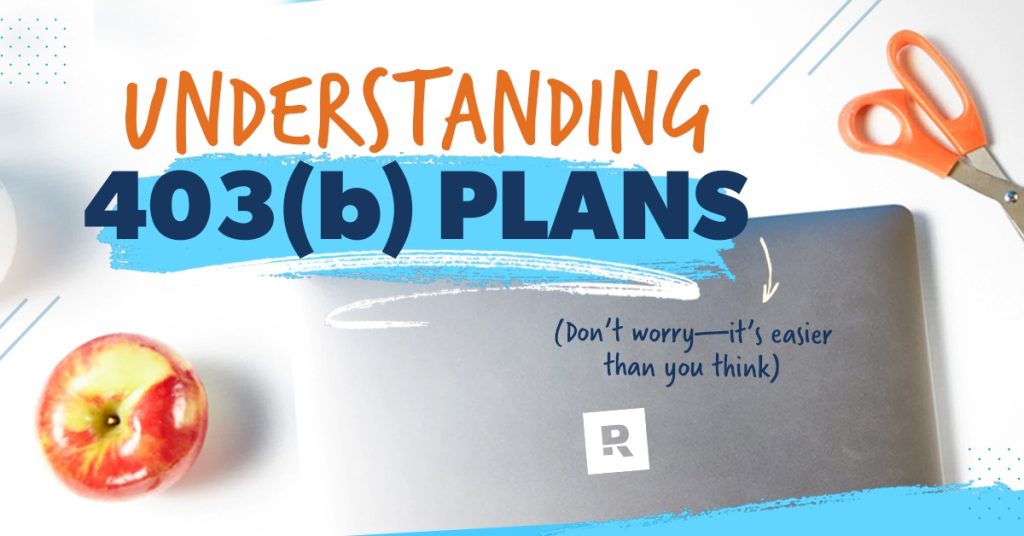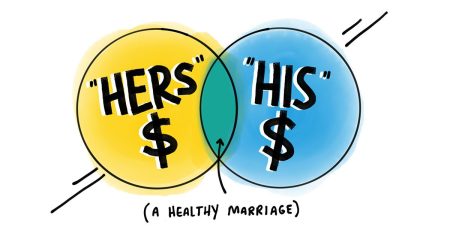If you work for a non-profit or tax-exempt organization, you might’ve noticed that something’s missing from your retirement options. Wait a minute, you say to yourself, why isn’t there a 401(k) option in here?
That’s because most teachers, government employees, nurses, doctors and others who spend their careers serving others have access to a different plan altogether. It’s called the 403(b).
If you’re not sure what it is or how it works, the 403(b) is an employer-sponsored investment account that helps you save for retirement. It works almost exactly the same as a 401(k)—with a few minor differences here and there.
Don’t worry, we’ll walk through all the nuts and bolts of the 403(b) together.
What Is a 403(b) Plan?
Simply put, a 403(b) is an employer-sponsored plan offered by public schools, nonprofits and other tax-exempt organizations to help employees save for retirement. Think of the 403(b) as a big bucket you put money into for your future. Then, when you retire, you draw your income from that bucket.
If you’re an educator or nonprofit worker, a 403(b) plan can be a great base for your retirement dreams if it offers solid mutual fund choices. Like the more well-known 401(k) plan, there are two main types of 403(b) plans—traditional or Roth—and the big difference between them is how they’re taxed.
Traditional 403(b)
These retirement plans are funded with pretax dollars and the money inside grows on a tax-deferred basis. That just means you won’t pay taxes on the money now, but you’ll be taxed on the withdrawals you take out in retirement.
Roth 403(b)
The word Roth gives us goosebumps because it means tax-free! (Well, mostly.) If your employer offers this option, grab it with both hands! With a Roth 403(b), you’re contributing after-tax dollars, so the money you put into it grows tax-free and you won’t pay any taxes when you take the money out in retirement.
But remember, only your contributions grow tax-free. If your company offers to match the money you put in (more on that in a minute), the money your company puts in grows tax-deferred. That means you will have to pay taxes on the match side of the account down the road.
How Does a 403(b) Plan Work?
You get to choose how much money you want to contribute to the plan, either a percentage of your salary or a set dollar amount, and that money will be taken out of your paycheck and invested in the options you choose.
And—bonus!—employers can contribute to your account as well (this is the match we mentioned earlier). If your employer offers a match, you’ll want to invest up to the match as soon as you’re ready to invest. People, it’s free money!
Now, a word of caution with 403(b)—these plans usually offer fewer choices than most 401(k) plans and could be loaded with insurance products like annuities with low returns, expensive fees and surrender charges. Steer clear of those and stick with good growth stock mutual funds!
Contribution Limits
Like other employer-sponsored plans, a 403(b) has contribution limits, early withdrawal penalties and tax implications. For 2024, the total contribution limit for a 403(b) is $23,000. But if you’re age 50 or older and need to catch up, you can put up to $30,500 into your account.1
And folks with a 403(b) have a nice advantage over their friends with a 401(k). According to the 15-year rule, employees with at least 15 years of service can add an extra $3,000 to their 403(b)s each year.2
The maximum amount that can be contributed to your 403(b) in 2024 between your contributions and your employer’s contributions is $69,000 per year (or $76,500, if you’re 50 or older) or your full annual salary—whichever amount is smaller.3
Withdrawals and Penalties
If you make a withdrawal (also called a distribution) from your 403(b) before you’re 59 1/2, you’ll have to pay a 10% early withdrawal penalty—and that’s on top of any taxes you owe on those withdrawals.4 Plus, you’d be losing the growth potential of those dollars and stealing from your future self. Bad idea all around!
Market chaos, inflation, your future—work with a pro to navigate this stuff.
Now, when you take money out of your 403(b) after age 59 1/2, or if you’re rolling the money from one qualified plan to another—like rolling over funds from a traditional 403(b) to a traditional IRA—then that’s a penalty-free withdrawal (but you’ll still have to pay any taxes you owe).
One exception to the early withdrawal penalty applies if you’re a member of the reserves. If you’re called to active duty for 179 days or more (thank you for your service!), you may be eligible for a qualified reservist distribution, which means the IRS 10% penalty won’t apply, but the distribution is still taxable.5
But just because you can do it doesn’t mean you should. Remember, you want to leave your retirement investments alone so they can keep compounding and growing!
Vesting
If your employer offers a 403(b) match, it’s always important to be on the lookout for any vesting requirements that come with the plan.
But wait, what is vesting again? When something is vested, it means you own it. When it’s vesting, you don’t own it yet—but you will after a set period of time. You might have to work at your university, church or nonprofit for a certain amount of time before you get to keep the entire amount of your employer match.
For example, let’s say you work at a school with a 403(b) plan that puts you on a four-year vesting schedule. That means once you’ve worked at the school for four years, then and only then will you own 100% of their contributions. But if you left for another job before you hit the four-year mark, you would take all the money you contributed, but you’d only take a portion of your school’s contributions while they keep the rest.
The good news is that many 403(b) plans vest funds in a shorter period of time than their 401(k) counterparts. And some even have immediate vesting, so the money from your employer contributions is yours from day one!
When Should I Invest in My 403(b)?
There is a time and a place for everything—and that applies to investing too. You know you’re ready to invest in your 403(b) when you’re out of debt (everything except your mortgage) and have a fully funded emergency fund.
If you still have debt payments or have very little money in savings, you need to hold off on investing—just for now! Why? Because trying to invest while your income is tied up in debt payments is like trying to climb a mountain with a backpack filled with bricks—you’re not going to get very far. So use the debt snowball and get debt out of your life as fast as you can!
And what about your emergency fund? Without one, you’ll be tempted to raid your 403(b) when your car gets wrecked or your heater breaks in the dead of winter. And that is never a good idea. Not only could that set your nest egg back hundreds of thousands of dollars over time, but you’ll also get smacked with taxes and early withdrawal penalties in the process.
That’s why having an emergency fund with 3–6 months’ worth of expenses before you start investing isn’t optional—it’s necessary. An emergency fund is there to protect your nest egg when life happens. And believe us, life will happen!
How Much Should I Invest in My 403(b)?
If your employer offers a match, you should at least invest enough to take full advantage of that free money! For example, let’s say your employer offers a dollar-for-dollar match on up to 5% of your $50,000 salary. If you invest up to the match, that’s an extra $2,500 your employer contributes to your 403(b) on top of what you invest yourself. That’s a no-brainer!
What about after you take advantage of the match? You should aim to save 15% of your income toward retirement, but does all of that need to be in your 403(b)? It depends. Here are a couple options to think about:
- Option 1: You have a Roth 403(b) with great mutual fund choices. This makes everything super simple. If you’re happy with your plan’s investment options, you can invest your whole 15% in your Roth 403(b). Done!
- Option 2: You have a traditional 403(b). Invest up to the match, then work with your financial advisor to open up a Roth IRA and max it out if you can! If you still haven’t hit 15% after maxing out your Roth IRA, you can go back to your traditional 403(b) and bump up your contributions until you do.
When in doubt, just remember this general rule of thumb about investing: Match beats Roth beats traditional. But above all, the best way to make sure you have enough for retirement is to keep putting money into your 403(b) month after month, year after year. You’ve got this!
What’s the Best Way to Invest Money in My 403(b)?
You want to make sure that your retirement portfolio—which includes your 403(b)—is diversified. That’s just a fancy way of saying you don’t want to put all your eggs in one basket!
How do you do that? Spread your investments in your 403(b) plan evenly between these four types of mutual funds: growth, growth and income, aggressive growth, and international. Even if you don’t have great funds to choose from, it’s still worth investing enough to get the company match (that’s free money, remember?).
Work with your financial advisor to pick mutual funds with a long history of strong returns. Your workplace 403(b) might not have as many fund options to choose from, but you can still make the most of the choices you do have.
What’s the Difference Between a 401(k) and 403(b)?
As you’ve probably figured out by now, the 401(k) and 403(b) are pretty much the same thing—they’re just a different part of the tax code! The only real difference between these two plans is who has access to them.
While 401(k)s are offered to employees at most privately owned businesses, 403(b)s are only offered to nonprofit, religious, school district and government workers.
Beyond that, there are some other minor differences we’ve already talked about. For example, 401(k) plans usually have more investing options to choose from than 403(b)s.
But 403(b) plans often come with shorter vesting schedules, which means you won’t have to wait long before your employer match is truly yours. And the 15-year rule allows long-tenured employees to invest even more of their hard-earned salary for retirement.
Work With a Pro
After a long and fulfilling career of taking care of others, wouldn’t it be nice to enjoy the fruits of your labor? It’s time to put your money to work so you can make your retirement dreams of spending time with family and traveling the world a reality.
According to The National Study of Millionaires, about 8 in 10 (79%) millionaires built their wealth through employer-sponsored retirement plans—just like the 403(b). And when we asked them what they did for a living, teaching was in the top three professions. You can do this!
The good news is you don’t have to figure it all out on your own. Our SmartVestor program can connect you with an investment professional who can walk you through your options today. Ready to get started?
Find your SmartVestor Pro today!
Read the full article here










